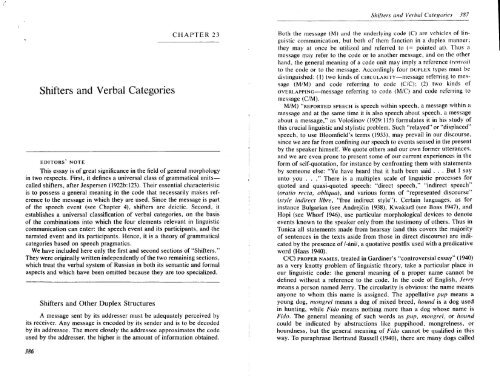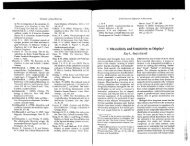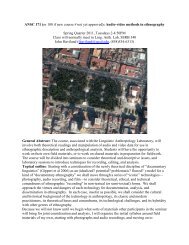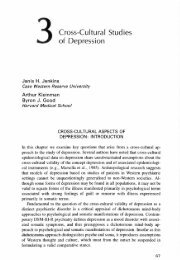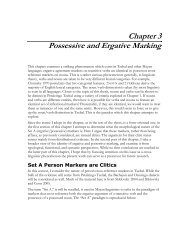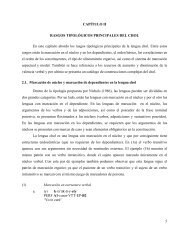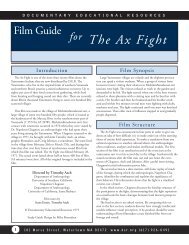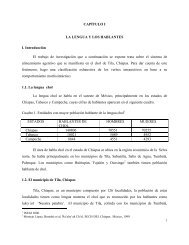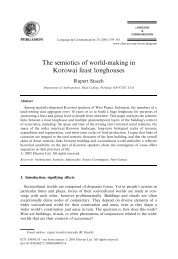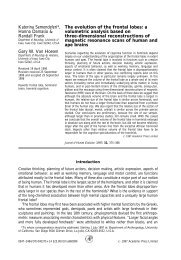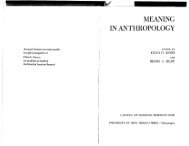Shifters and Verbal Categories
Shifters and Verbal Categories
Shifters and Verbal Categories
You also want an ePaper? Increase the reach of your titles
YUMPU automatically turns print PDFs into web optimized ePapers that Google loves.
<strong>Shifters</strong> <strong>and</strong> <strong>Verbal</strong> <strong>Categories</strong><br />
EDITORS' NOTE<br />
CHAPTER 23<br />
This essay is of great significance in the field of general morphology<br />
in two respects. First, it defines a universal class of grammatical units-<br />
called shifters, after Jespersen (1922b: 123). Their essential characteristic<br />
is to possess a general meaning in the code that necessarily makes ref-<br />
erence to the message in which they are used. Since the message is part<br />
of the speech event (see Chapter 4), shifters are deictic. Second, it<br />
establishes a universal classification of verbal categories, on the basis<br />
of the combinations into which the four elements relevant in linguistic<br />
communication can enter: the speech event <strong>and</strong> its participants, <strong>and</strong> the<br />
narrated event <strong>and</strong> its participants. Hence, it is a theory of g~ammatical<br />
categories based on speech pragmatics.<br />
We have included here only the first <strong>and</strong> second sections of "<strong>Shifters</strong>."<br />
They were originally written independently of the two remaining sections,<br />
which treat the verbal system of Russian in both its semantic <strong>and</strong> formal<br />
aspects <strong>and</strong> which have been omitted because they are too specialized.<br />
<strong>Shifters</strong> <strong>and</strong> Other Duplex Structures<br />
A message sent by its addresser must be adequately perceived by<br />
its receiver. Any message is encoded by its sender <strong>and</strong> is to be decoded<br />
by its addressee. The more closely the addressee approximates the code<br />
used by the addresser, the higher is the amount of information obtained.<br />
386<br />
ShiJiers <strong>and</strong> <strong>Verbal</strong> Cnregories 387<br />
Both the message (M) <strong>and</strong> the underlying code (C) are vehicles of linguistic<br />
communication, but both of them function in a duplex manner:<br />
they may at once be utilized <strong>and</strong> referred to (= pointed at). Thus a<br />
message may refer to the code or to another message, <strong>and</strong> on the other<br />
h<strong>and</strong>, the general meaning of a code unit may imply a reference (ren~wi)<br />
to the code or to the message. Accordingly four DUPLEX types must be<br />
distinguished: ( I) two kinds of CIRCULARITY-message referring to message<br />
(MIM) <strong>and</strong> code referring to code (CIC); (2) two kinds of<br />
OVERLAPPING-message referring to code (MIC) <strong>and</strong> code referring to<br />
message (CIM).<br />
M/M) "REPORTED SPEECH is speech within speech, a message within a<br />
message <strong>and</strong> at the same time it is also speech about speech, a message<br />
about a message," as Voloiinov (1929:115) formulates it in his study of<br />
this crucial linguistic <strong>and</strong> stylistic problem. Such "relayed" or "displaced"<br />
speech, to use Bloomfield's terms (1933), may prevail in our discourse,<br />
since we are far from confining our speech to events sensed in the present<br />
by the speaker himself. We quote others <strong>and</strong> our own former utterances.<br />
<strong>and</strong> we are even prone to present some of our current experiences in the<br />
form of self-quotation, for instance by confronting them with statements<br />
by someone else: "Ye have heard that it hath been said . . . But I say<br />
unto you . . ." There is a multiplex scale of linguistic processes for<br />
quoted <strong>and</strong> quasi-quoted speech: "direct speech," "indirect speech"<br />
(oratio recta, obliqua), <strong>and</strong> various forms of "represented discourse"<br />
(style indirect libre, "free indirect style"). Certain languages, as for<br />
instance Bulgarian (see AndrejEin 1938), Kwakiutl (see Boas 1947), <strong>and</strong><br />
Hopi (see Whorf 1946), use particular morphological devices to denote<br />
events known to the speaker only from the testimony of others. Thus in<br />
Tunica all statements made from hearsay (<strong>and</strong> this covers the majority<br />
of sentences in the texts aside from those in direct discourse) are indicated<br />
by the presence of 1-&nil, a quotative postfix used with a predicative<br />
word (Haas 1940).<br />
CIC) PROPER NAMES, treated in Gardiner's "controversial essay" (1940)<br />
as a very knotty problem of linguistic theory, take a particular place in<br />
our linguistic code: the general meaning of a proper name cannot be<br />
defined without a reference to the code. In the code of English, Jerry<br />
means a person named Jerry. The circularity is obvious: the name means<br />
anyone to whom this name is assigned. The appellative pup means a<br />
young dog, mongrel means a dog of mixed breed, hound is a dog used<br />
in hunting, while Fido means nothing more than a dog whose name is<br />
Fido. The general meaning of such words as pup, mongrel, or hound<br />
could be indicated by abstractions like puppihood, mongrelness, or<br />
houndness, but the general meaning of Fido cannot be qualified in this<br />
way. To paraphrase Bertr<strong>and</strong> Russell (1940), there are many dogs called
388 MEANING IN LANGUAGE: GRAMMATICAL AND LEXICA1 Shifirrs <strong>and</strong> Vrrhal Cate,qories 389<br />
Fido, but they do not share any property of "Fidone\s." Also thc indefinite<br />
pronoun corresponding to names such as Jean. Jan, Joan. Junethe<br />
"what's-her-name" or "what-do-you-call-her" or "how-d'ye-callherw-includes<br />
a patent reference to the code.<br />
MIC) A message referring to the code is in logic termed an AUTONY-<br />
MOUS mode of speech.' When we say, The pup is u ~c*insome anitncrl or<br />
The pup is rvhlmpering, the word pup designates a young dog, whereas<br />
in such sentences as "Pup" is a nom which means ci young dog or. more<br />
briefly, "Pup" means a young dog or "Pup" is u monosyllable, the word<br />
pup-one may state with Carnap (1937)-is used as its own designation.<br />
Any elucidating interpretation of words <strong>and</strong> sentences-whether intralingual<br />
(circumlocutions, synonyms) or interlingual (translation)-is a<br />
message referring to the code. Such a hypostasis-as Bloomfield<br />
(1933: 148) pointed out-"is closely related to quotation, the repetition of<br />
speech," <strong>and</strong> it plays a vital role in the acquisition <strong>and</strong> use of language.<br />
CIM) Any linguistic code contains a particular class of grammatical<br />
units which Jespersen (1922b) labeled SHIFTERS: the general meaning of<br />
a shifter cannot be defined without a reference to the message.<br />
Their semiotic nature was discussed by Burks (1949) in his study on<br />
Peirce's classification of signs into symbols, indices, <strong>and</strong> icons.<br />
According to Peirce, a symbol (for example the English word red) is<br />
associated with the represented object by a conventional rule, while an<br />
index (such as the act of pointing) is in existential relation with the object<br />
it represents. <strong>Shifters</strong> combine both functions <strong>and</strong> belong therefore to<br />
the class of INDEXICAL SYMBOLS. AS a striking example Burks cites the<br />
personal pronoun. I means the person uttering I. Thus on one h<strong>and</strong>, the<br />
sign I cannot represent its object without being associated with the latter<br />
"by a conventional rule," <strong>and</strong> in different codes the same meaning is<br />
assigned to different sequences such as I, ego, ich, <strong>and</strong> ja: consequently<br />
I is a symbol. On the other h<strong>and</strong>, the sign I cannot represent its object<br />
without "being in existential relation" with this object: the word I des-<br />
ignating the utterer is existentially related to his utterance <strong>and</strong> hence<br />
functions as an index (see Benveniste 1956).<br />
The peculiarity of the personal pronoun <strong>and</strong> other shifters was often<br />
believed to consist in the lack of a single, constant, general meaning.<br />
Husserl (1913): "The word 'I' designates a different person in each case<br />
<strong>and</strong> it does this always by means of a new meaning." For this alleged<br />
multiplicity of contextual meanings, shifters in contradistinction to sym-<br />
bols were treated as mere indices (Buhler 1934). Every shifter, however,<br />
possesses its own general meaning. Thus I means the addresser (<strong>and</strong><br />
you, the addressee) of the message to which it belongs. For Bertr<strong>and</strong><br />
Russell, shifters, or in his terms "egocentric particulars," are defined by<br />
the fact that they never apply to more than one thing at a time. This.<br />
hpwever, is common to all the syncategorematic terms For example the<br />
con.iunction twt each time expresses ;in adversative relation between two<br />
stated concepts <strong>and</strong> not the generic idea of contrariety. In fact, shifters<br />
are distinguished from all other constituents of the linguistic code solely<br />
by their compulsory reference to the given message.<br />
The indexical symbols. <strong>and</strong> in particular the personal pronouns. which<br />
the Humboldtian tradition conceives of as the most elementary <strong>and</strong> primitive<br />
stratum of language, are. on the contrary. a complex category where<br />
code <strong>and</strong> message overl;rp. Therefore pronouns belong to the late acquisitions<br />
in child language <strong>and</strong> to the early losses in aphasia. If we observe<br />
that even linguistic scientists had difficulties in defining the general<br />
meaning of the term i (or you), which signifies the same intermittent<br />
function of different subjects, it is quite obvious that the child who has<br />
learned to identify himself with his proper name will not easily become<br />
accustomed to such alienable terms as the personal pronouns: he may<br />
be afraid of speaking of himself in the first person while being called yo11<br />
by his interlocutors. Sometimes he attempts to redistribute these appellations.<br />
For instance, he tries to monopolize the first person pronoun:<br />
"Don't dare call yourself I. Only I am I, <strong>and</strong> you are only you." Or he<br />
uses indiscriminately either I or you both for the addresser <strong>and</strong> the<br />
addressee so that this pronoun means any participant of the given dialogue.<br />
Or finally I is so rigorously substituted by the child for his proper<br />
name that he readily names any person of his surroundings but stubbornly<br />
refuses to utter his own name: the name has for its little bearer only a<br />
vocative meaning, opposed to the nominative functiqn of I. This attitude<br />
may persevere as an infantile survival. Thus Guy de Maupassant confessed<br />
that his name sounded quite strange to him when pronounced by<br />
himself. The refusal to utter one's own name may become a social<br />
custom. Zelenin (1930) notes that in the Samoyed society the name was<br />
taboo for its carrier.<br />
Jim told me "Jicksks" tneans "movies." This brief utterance includes all<br />
four types of duplex structures: reported speech (MIM), the autonymous<br />
form of speech (MIC), a proper name (CIC), <strong>and</strong> shifters (CIM), namely<br />
the first-person pronoun <strong>and</strong> the preterit, signaling an event prior to the<br />
delivery of the message. In language <strong>and</strong> in the use of language, duplicity<br />
plays a cardinal role. In particular, the classification of grammatical, <strong>and</strong><br />
especially verbal, categories requires a consistent discrimination of<br />
shifters.<br />
Attempt to Classify. <strong>Verbal</strong> <strong>Categories</strong><br />
In order to classify the verbal categories two basic distinctions are<br />
to be observed:
390 MEANING IN LANGUAGE: GRAMMATICAL AND LEXICAL.<br />
1. speech itself (0, <strong>and</strong> its topic, the narrated matter (");<br />
2. the event itself (E). <strong>and</strong> any of its participants (P), whether<br />
"performer" or "undergoer."<br />
Consequently four items are to be distinguished: a narrated event (En),<br />
a speech event (Es), a participant of the narrated event (Pn), <strong>and</strong> a<br />
participant of the speech event (P'), whether addresser or addressee.<br />
Any verb is concerned with a narrated event. <strong>Verbal</strong> categories may<br />
be subdivided into those which do <strong>and</strong> those which do not involve the<br />
participants of the event. <strong>Categories</strong> involving the participants may characterize<br />
either the participants themselves (Pn) or their relation to the<br />
narrated event (PnEn). <strong>Categories</strong> abstracting from the participants characterize<br />
either the narrated event itself (En) or its relation to another<br />
narrated event (EnEn). For categories characterizing only one narrated<br />
item-either the event (En) itself or its participants (Pn) themselves-the<br />
term DESIGNATORS will be used, while those categories which characterize<br />
a narrated item (En or Pn) with respect to another narrated item<br />
(EnEn or PnEn) will be termed CONNECTORS. I<br />
Designators indicate either the quality or the quantity of the narrated<br />
item <strong>and</strong> may be termed QUALIFIERS <strong>and</strong> QUANTIFIERS respectively.<br />
Both designators <strong>and</strong> connectors may characterize the narrated event<br />
(procPs de I'e'nonce') <strong>and</strong>/or its participants either without or with reference<br />
to the speech event (proces de l'e'nonciation) (.../Es) or its participants<br />
(...IPS). <strong>Categories</strong> implying such a reference are to be termed<br />
SHIFTERS; those without such a reference are NONSHIFTERS.<br />
With regard to these basic dichotomies any generic verbal category<br />
can be defined.<br />
Pn) Among categories involving the participants of the narrated event,<br />
GENDER <strong>and</strong> NUMBER characterize the participants themselves without<br />
reference to the speech event-gender qualifies, <strong>and</strong> number quantifies<br />
the participants. In Algonquian, for example, verbal forms indicate<br />
whether the performer, on the one h<strong>and</strong>, <strong>and</strong> the undergoer, on the other,<br />
are animate or inanimate (Bloomfield 1946); <strong>and</strong> the singleness, duality,<br />
or multiplicity of performers as well as undergoers is expressed in Koryak<br />
conjugation (Bogoraz 1922).<br />
Pn/P" PERSON characterizes the participants of the narrated event with<br />
reference to the participants of the speech event. Thus first person signals<br />
the identity of a participant of the narrated event with the performer of<br />
the speech event, <strong>and</strong> the second person, the identity with the actual or<br />
potential undergoer of the speech event.<br />
En) STATUS <strong>and</strong> ASPECT characterize the narrated event itself without<br />
involving its participants <strong>and</strong> without reference to the speech event.<br />
Status (in Whorf's terminology) defines the logical quality of the event.<br />
<strong>Shifters</strong> crrrd <strong>Verbal</strong> <strong>Categories</strong> 391<br />
For example in Gilyak, the affirmative, presumptive. negative. interrog-<br />
ative, <strong>and</strong> negative-interrogative statuses are expressed by special verbal<br />
forms (Krejnovii: 1934). In English the assertive status uses the "do"-<br />
combinations which in certain conditions are optional for an affir-<br />
mative assertion but compulsory for a negative or questioned assertion.<br />
Aspect quantifies the narrated event.<br />
EnE" TENSE characterizes the narrated event with reference to the<br />
speech event. Thus the preterit informs us that the narrated event is<br />
anterior to the speech event.<br />
YEn) VOICE characterizes the relation between the narrated event <strong>and</strong><br />
its participants without reference to the speech event or to the speaker.<br />
PnEn/P" MOOD characterizes the relation between the narrated event<br />
<strong>and</strong> its participants with reference to the participants of the speech event:<br />
in Vinogradov's formulation, this category "reflects the speaker's view<br />
of the character of the connection between the action <strong>and</strong> the actor or<br />
the goal" (1947).<br />
EnEn) There is no st<strong>and</strong>ardized name for this category; such labels as<br />
"relative tense" cover only one of its varieties. Bloomfield's (1946) term<br />
"order" or rather its Greek model "taxis" seems to be the most appro-<br />
priate. TAXIS characterizes the narrated event in relation to another nar-<br />
rated event <strong>and</strong> without reference to the speech event, thus Gilyak dis-<br />
tinguishes three kinds of independent taxis-one requires, one admits,<br />
<strong>and</strong> one excludes a dependent taxis, <strong>and</strong> the dependent taxes express<br />
various relationships with the independent verb-simultaneity, ante-<br />
Table 23.1 <strong>Verbal</strong> categories<br />
Reference Participant involved<br />
to narrated<br />
item Designator Connector<br />
Nonshifter Qualifier: Gender, Voice<br />
Quantifier: Number<br />
Shifter Person Mood<br />
Table 23.2 <strong>Shifters</strong> <strong>and</strong> nonshifters<br />
--<br />
Participant not involved<br />
Designator Connector<br />
Qualifier: Status, Taxis<br />
Quantifier: Aspect<br />
Tense Evidential<br />
Reference to<br />
Participant involved Participant not involved<br />
narrated item Designator Connector Designator Connector<br />
Nonshifter Pn PnEn En EnEn<br />
Shifter PnIPs PnEn/Ps EnIEs EnEns/Es
iority, interruption, concessive connection, etc. A similar Hopi pattern<br />
is described by Whorf.<br />
EnEnVEs) EVIDENTIAL is a tentative label for the verbal category which<br />
takes into account three events-a narrated event, a speech event, <strong>and</strong><br />
a narrated speech event (En'), namely the alleged source of information<br />
about the narrated event. The speaker reports an event on the basis of<br />
someone else's report (quotative, i.e. hearsay evidence), of a dreani<br />
(revelative evidence), of a guess (presumptive evidence), or of his own<br />
previous experience (memory evidence). Bulgarian conjugation dis-<br />
tinguishes two semantically opposite sets of forms: "direct narration"<br />
(Ens = ES) versus "indirect narration" (En" Es). To our question, what<br />
happened to the steamer Etpdokija, a Bulgarian first answered, zcltrlincila<br />
(it is claimed to have sailed), <strong>and</strong> then added, zarnina (I bear witness; it<br />
sailed). (Cf. H. G. Lunt [I9521 on the systematic distinction made in the<br />
Macedonian verbal pattern between "vouched for" <strong>and</strong> "distanced"<br />
events.)<br />
The interrelation of all these generic categories may be illustrated by<br />
the overall scheme in Table 23.1. With special regard to the opposition<br />
shifters versus nonshifters, we condense this model into the simpler<br />
format appearing in Table 23.2.<br />
Sound <strong>and</strong> Meaning<br />
in Language:<br />
Their Interrelations


